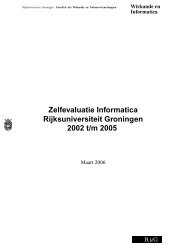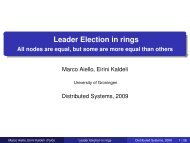Reverse Engineering – Recent Advances and Applications
Reverse Engineering – Recent Advances and Applications
Reverse Engineering – Recent Advances and Applications
You also want an ePaper? Increase the reach of your titles
YUMPU automatically turns print PDFs into web optimized ePapers that Google loves.
20 <strong>Reverse</strong> <strong>Engineering</strong> <strong>–</strong> <strong>Recent</strong> <strong>Advances</strong> <strong>and</strong> <strong>Applications</strong><br />
18 Will-be-set-by-IN-TECH<br />
used. 16 Robust extractors can recognize embedded assembly, but analyzing it is beyond their<br />
capabilites (Balakrishnan & Reps, 2010).<br />
Extracting facts from the running system has the advantage that generic monitoring<br />
functionality is typically provided by the hardware <strong>and</strong> the real-time operating system.<br />
However, obtaining finer-grained facts of the system’s behavior is often prohibitive because<br />
of the monitoring overhead <strong>and</strong> the probing effect. The amount of tracing data is restricted by<br />
the hardware resources. For instance, for ABB robots around 10 seconds (100,000 events) of<br />
history are available, which are kept in a ring buffer (Kraft et al., 2010). For the Darwin project,<br />
Arias et al. (2011) say “we observed that practitioners developing large <strong>and</strong> complex software<br />
systems desire minimal changes in the source code [<strong>and</strong>] minimal overhead in the system<br />
response time.” In the E-CARES project, tracing data could be collected within an emulator<br />
(using a virtual time mode); since tracing jobs have highest priority, in the real environment<br />
the system could experience timing problems (Marburger & Herzberg, 2001).<br />
For finer-grained tracing data, strategic decisions on what information needs to be traced<br />
have to be made. Thus, data extraction <strong>and</strong> data use (analysis <strong>and</strong> visualization) have to<br />
be coordinated. Also, to obtain certain events the source code may have to be selectively<br />
instrumented in some form. As a result, tracing solutions cannot exclusively rely on generic<br />
approaches, but need to be tailored to fit a particular goal. The Darwin project proposes a<br />
tailorable architecture reconstruction approach based on logging <strong>and</strong> run-time information.<br />
The approach makes “opportunistic” use of existing logging information based on the<br />
assumption that “logging is a feature often implemented as part of large software systems<br />
to record <strong>and</strong> store information of their specific activities into dedicated files” (Arias et al.,<br />
2011).<br />
After many years of research on scalable <strong>and</strong> robust static fact extractors, mature tools have<br />
finally emerged for C, but they are still challenged by the idiosyncracies of complex embedded<br />
systems. For C++ we are not aware of solutions that have reached a level of maturity that<br />
matches C, especially considering the latest iteration of the st<strong>and</strong>ard, C++11. Extraction of<br />
dynamic information is also more challenging for complex embedded systems compared to<br />
desktop applications, but they are attractive because for many systems they are relatively easy<br />
to realize while providing valuable information to better underst<strong>and</strong> <strong>and</strong> evolve the system.<br />
5.2 Static analyses<br />
Industry is using static analysis tools for the evolution of embedded systems <strong>and</strong> there is a<br />
broad range of them. Examples of common static checks include stack space analysis, memory<br />
leakage, race conditions, <strong>and</strong> data/control coupling. Examples of tools are PC-lint (Gimpel<br />
Software), CodeSurfer, <strong>and</strong> Coverity Static Analysis. While these checkers are not strictly<br />
reverse engineering analyses, they can aid program underst<strong>and</strong>ing.<br />
Static checkers for complex embedded systems face several adoption hurdles. Introducing<br />
them for an existing large system produces a huge amount of diagnostic messages, many<br />
of which are false positives. Processing these messages requires manual effort <strong>and</strong> is often<br />
prohibitively expensive. (For instance, Boogerd & Moonen (2009) report on a study where<br />
16 The developers of the Coverity tool say (Bessey et al., 2010): “Assembly is the most consistently<br />
troublesome construct. It’s already non-portable, so compilers seem to almost deliberately use weird<br />
syntax, making it difficult to h<strong>and</strong>le in a general way.”




